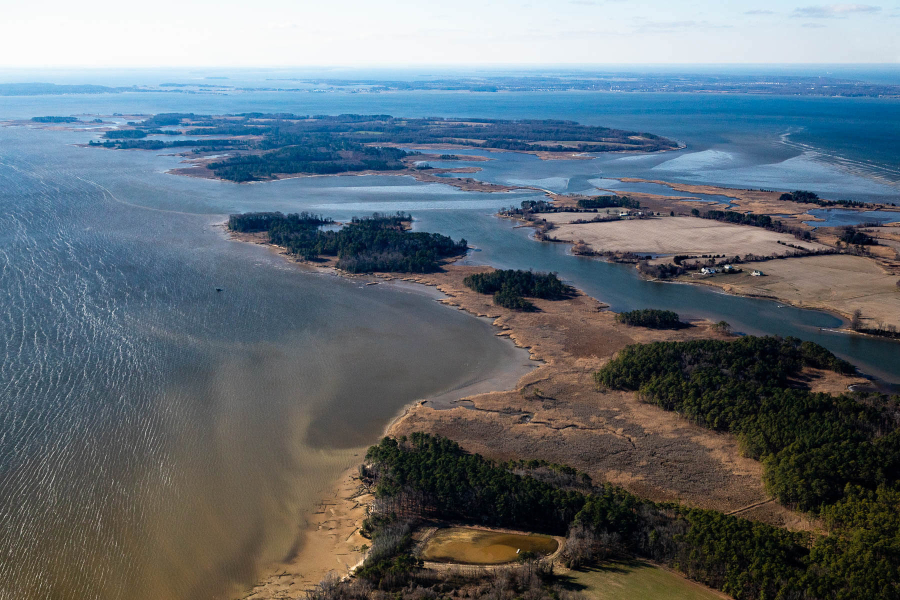Thanks to the weather and efforts to reduce pollution, the 2020 dead zone remains small

When Hurricane Isaias came through the Chesapeake Bay in August 2020, it had one positive impact: it stirred up the waters of the Bay, helping to reduce the annual dead zone. The hurricane’s strong winds, as well as cooler-than-normal air temperatures in May and September, created the perfect conditions for a small 2020 dead zone, which were further enhanced by pollution reducing strategies put into place over the years by dedicated government agencies, organizations, businesses and individuals.
The dead zone is an area of little to no oxygen that forms in deep Bay waters when excess nutrients, including both nitrogen and phosphorus, enter the water through polluted runoff and feed naturally-occurring algae. This drives the growth of algae blooms, which eventually die and decompose, removing oxygen from the surrounding waters faster than it can be replenished. This creates low-oxygen—or hypoxic—conditions at the bottom of the Bay. Plant and animal life are often unable to survive in this environment, which is why the area is referred to as a “dead zone.”
Weather conditions play a large role in the size and duration of the dead zone. Heavy rainfall can lead to high river flows entering the Bay, which can carry increased amounts of nutrient pollution. When river flows are above-average and temperatures are hot, the dead zone can be larger and last longer, which is what happened in 2019.
In 2020, however, the U.S. Geological Survey reported normal river flows entering the Bay at an average of 77,655 cubic feet per second, which is slightly below the long-term average of 79,000 cubic feet per second. These average river flows, along with cooler temperatures in May and September, provided the perfect conditions for a smaller dead zone.
The Maryland Department of Natural Resources conducts monitoring cruises throughout the summer to keep an eye on the dead zone. This year, only one out of the eight cruises showed larger-than-average hypoxic conditions. This was in late July and it occurred as a result of below average winds and the hottest temperatures ever recorded in Maryland. The arrival of Hurricane Isaias in August quickly helped to reduce its size, causing the 2020 dead zone to also end earlier than it has in the past several years.
The Maryland Department of Natural Resources posts the results of its monitoring cruises for the Maryland portion of the Bay on its Eyes on the Bay website. Scientists at the Virginia Institute of Marine Science (VIMS) also produce daily, real-time estimates of the size of the dead zone for the entire Bay, along with hypoxia forecasts, which they summarize each year in their annual Chesapeake Bay Dead Zone Report Card.
“Our analyses at VIMS are helping us to better understand how and why the dead zone changes in size from year to year,” said Dr. Marjy Friedrichs, a research professor with VIMS. “After we account for year-to-year differences in summer weather, the general trend we’re seeing is that hypoxia has been decreasing with time, as a result of reductions in the amount of nutrients flowing into the Bay over the past decades. The fact that we’re seeing decreased hypoxia despite significantly warmer summer temperatures is a testament to the fact that management actions to curb nutrient pollution are working.”
Want to help keep the dead zone small? Visit our Tips and Tricks page and see what you can do to keep nitrogen and phosphorus from entering the Bay.

Comments
This is encouraging news. Myself and countless other governmental agencies here in York PA have been working tirelessly every day to reduce our polluted runoff with hopes of seeing increasing quality of the Bay's waters. This is a nice breath of fresh air for us to get such a positive report for 2020. I hope we can keep this momentum going! Thank you again for sharing this information!
Thank you!
Your comment has been received. Before it can be published, the comment will be reviewed by our team to ensure it adheres with our rules of engagement.
Back to recent stories